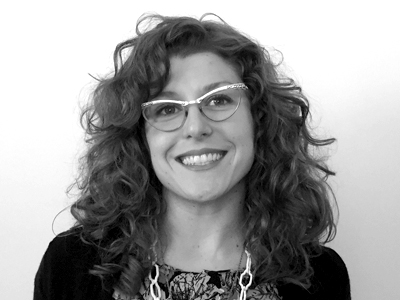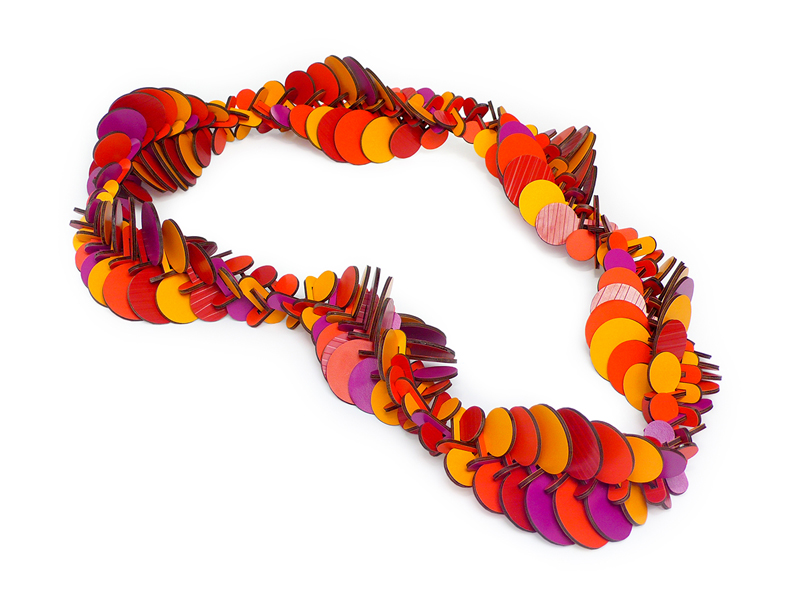
The brightly colored, interlocking, laminate shapes that form the perplexingly composed necklaces and brooches in Rebecca Hannon’s recent exhibition Contemporary Camouflage are the result of investigations into the effects color has on form, and the complex configurations made possible through laser cutting and 3-D printing technologies. In this interview, Hannon shares details about her inquisitive approach to nonprecious materials, and illustrates the value of research opportunities that allow mid-career artists to thrive.
Adriane: Tell us about your background, where you are from, and where you live currently.
Rebecca Hannon: I am from suburban Washington, D.C., the “planned community” of Reston, Virginia. It was actually a pretty good plan, as low-income housing was built next to mansions; everyone grew up together and went to public school together. Our community was diverse and inclusive and we certainly all benefited from this richness. Since then I have moved cities or countries every five years, but I am currently at the seven-year mark in Halifax, Nova Scotia, Canada.
When did you become interested in jewelry, and what sustains your interest as your career progresses?
Rebecca Hannon: My high school art teacher invited me to be his metalsmithing assistant at Interlochen Center for the Arts. Although I wasn’t much older than some campers, my world was blown open by the possibilities of making art jewelry. I remember he had a book of Hermann Jünger’s jewelry. I thought I would never see anything so fantastic again and proceeded to redraw all of Jünger’s pieces in my journal. I continue to work in this field because I usually have a research question I am pursuing, as well as exploring the strengths and limitations of new materials. Making adornment is the best way for me to answer these questions. I have also had a number of great opportunities in my career, and helping find opportunities or enabling the dreams of others also drives me.

Between the time of your undergraduate studies at RISD and your Fulbright Scholarship to study in Munich, you worked as a goldsmith. What compelled you to pursue studio jewelry? Does your experience as a goldsmith retain any bearing on your practice?
Rebecca Hannon: It is interesting to me that you see that as a divide—studio jewelry and goldsmithing. A goldsmith’s training is definitely how I approach all aspects of my studio practice (and probably life!). For a bit of background—when I did my undergraduate degree at RISD, it was not yet the moment for “alternative materials.” Even use of stones was a bit frowned upon. We used mostly metals, and I received a solid technical education. Working as a goldsmith for five years in NYC taught me to work fast, and taught me about the responsibility of being entrusted with/setting a client’s stone. I gleaned these new skills as well as having the luxurious opportunity to work with gold.
When I went to the Künste Akademie in Munich, it was a different moment in time. Dryer lint was being glue-gunned together, and it definitely took some time for me to forget some aspects of a traditional background and open up to new possibilities in the field. I approach my work today with quotidian materials, as if they were precious. I am a stickler for craftsmanship when I teach foundation-year classes; students can always seek elsewhere for advocates of “sloppy craft.”
Much of your work is made from nonprecious materials such as horsehair, eggshells, compact discs, Tyvek™, and, recently, plastic laminate. What draws you to a material, and how do you know when you’ve come across one that you want to work with?
Rebecca Hannon: The root of my reason for turning toward alternate materials was color. When I made the switch, I found that all of these new materials held their own embedded stories. A used thimble speaks of women’s work, the lost art of repair, protection… These embedded stories continue to delight me, and often provide a rich foundation for a new work, but I am just back from three months in India, and I must say I am feeling a bit nostalgic for gold.
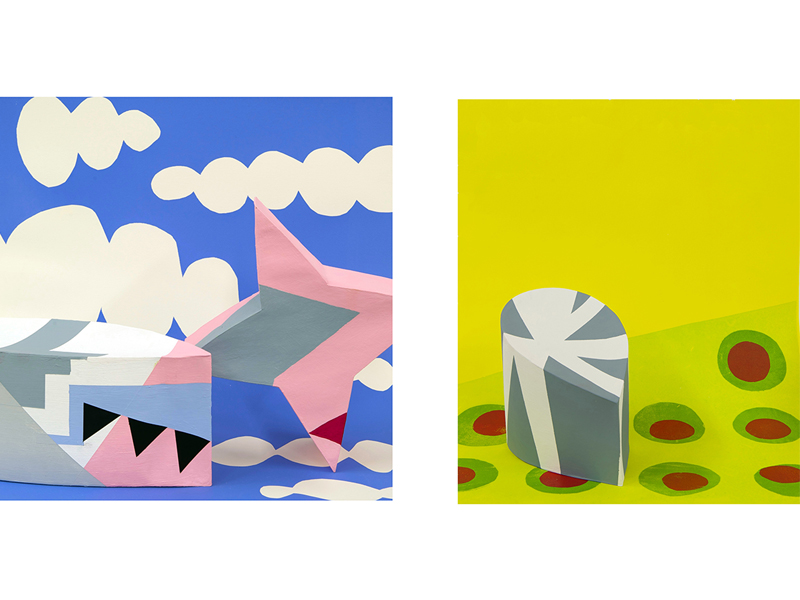
How do you develop your work? Describe your process and what a day in your studio is like.
Rebecca Hannon: Days in the studio are fleeting during the academic year, and intense and directed in summer. In recent years I have participated in residency programs, often as a way to divide the time between academia and studio immersion, as well as offering contact with new people and cultures, which feeds my work. I am always reading and writing to develop a structural framework I can build upon when I get in my studio. My studio days could be making new renderings on a computer, sitting in front of a laser cutter and trying to ignore the char smell, or doing fabrication and assembly in my studio in a shared artist’s collective.
You are one of the 2015 recipients of a SNAG Mid-Career Award, which provides funding for professional development. What opportunity did you pursue, and what impact has this had on your practice?
Rebecca Hannon: First, I am so thankful that SNAG created a Mid-Career Award, and now Susan Beech has also recently created a Mid-Career Grant. The years are long between “emerging artist” and “lifetime achievement,” and any encouragement or support helps us to thrive. My award allowed me to participate in a residency at the Banff Centre for Arts and Creativity. I stepped away from jewelry and did an investigation of how 2-D surface pattern affects our perception of 3-D form. My line of inquiry was based on theories of protective coloration in nature, as well as dazzle camouflage used in WWI. I created a library of 3-D shapes, applied pattern to their surface, and printed monotype “backdrops.” The shapes were photographed in their new environments, and the 3-D world was made flat again. This series is still evolving and may eventually lead to a series of adornment.
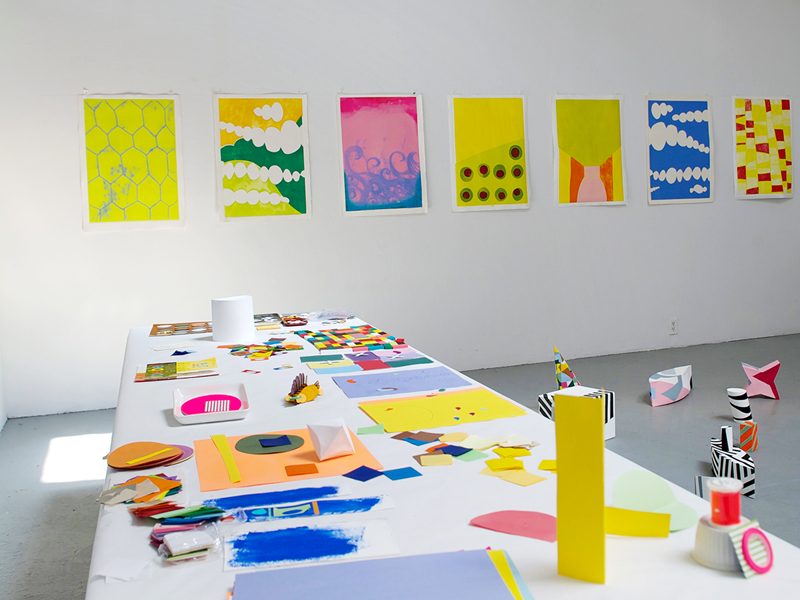
What role does research play in your studio practice?
Rebecca Hannon: Reading, thinking through craft, travel, finding ways to connect with people and their unique cultural histories all form the research vital to my studio practice.
The works displayed in Contemporary Camouflage are made from colorful, interlocking laminate shapes. Can you elaborate on the research that led you to these forms and the significance of your material, shapes, and colors?
Rebecca Hannon: Investigation into the relationship of color/pattern on form, and form as it relates to the human body, has been my interest for many years. Contemporary Camouflage was an extension of the research I had begun at Banff in tandem with the colorful laser-cut laminate compositions I have made for a number of years. I explored notions of conceal/reveal found in the natural world, and the dazzling world of personal adornment. A favorite from this exhibition is the Bloomers neckpiece, which employs colorways on alternate sides of the piece that are found on both the coral snake and kingsnake. The coral snake is acutely poisonous and ringed in red, yellow, and black. The kingsnake is benign, but mimics his poisonous brethren with stripes of red ringed with black. So a traditional saying goes, “red touches yellow, kills a fellow, red next to black, venom lack.”

The laminate necklaces, entitled Crown of Thorns, reference an American folk art (or tramp art) object, which is a puzzle-like configuration made by hand using wood from cigar boxes. The title also has religious connotations. Does religion factor into your interpretation of these forms?
Rebecca Hannon: I love folk art and outsider art and really any works that are made by people who are passionate and intuitive about what they are creating. I stumbled upon a “Crown of Thorns” picture frame a few years ago, and after taking it apart to understand its construction and linking system, found a pattern that was endlessly variable. This discovery has led to an evolving series of neckpieces whose complexity I continually try to intensify. The traditional religious title is not a factor for me, and, amazingly, when I recently showed these works in Amsterdam, someone approached me and asked if the neckpieces were based on a Swedish beer brewer’s yeast ring. A quick Google search revealed this is also the same form.
Your website contains many descriptive texts, not only about the conception of bodies of work but on individual works as well. Is writing a crucial component of your practice?
Rebecca Hannon: I may write a text or a proposal, but I usually approach new projects in an intuitive way. When complete, writing helps me stitch together various thoughts and encounters and it is often revelatory. Analyzing particular pieces when they are complete helps me recognize intention and connective threads.

What have you read lately?
No One Belongs Here More Than You, by Miranda July, whose tales of an oddball 40-something woman are not hitting close to home. An article in The Atlantic turned me on to the work of Tristan Harris, and his “call to minimize distraction & respect users’ attention” in relation to our mobile devices. He encourages “ethical software design” and sheds light on forces competing to hijack our attention span. I had never considered this, but it affects my studio practice and life, so I am trying to be more mindful.
Who are some artists whose works you admire?
West Coast jeweler Karin Jones is making compelling work that makes me think, and Aurélie Guillaume is making delightful brooches that bring me joy.
What is next for you? Exhibitions? Research?
Rebecca Hannon: Yes, always! My current dream is to acquire my own laser cutter so I could be much more nimble in my making.
Thank you.
The works in the show range in price from $180 to $3,500.
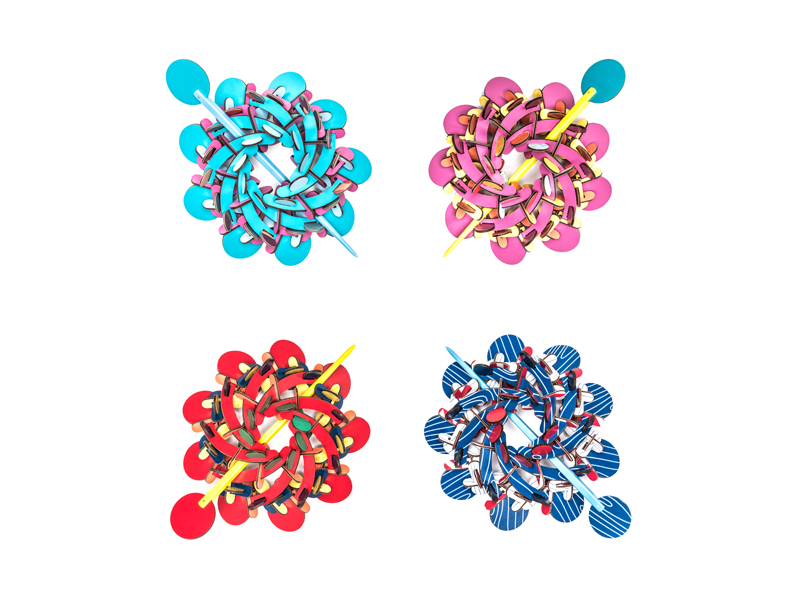
INDEX IMAGE: Rebecca Hannon, Doxie Brooches, 2016, laminate, sterling silver, steel, 85 x 85 x 30 mm, photo: Katherine Nakaska
***
インタビュー
2016年11月25日
レベッカ・ハノン:コンテンポラリー・カモフラージュ
ギャラリー・ノエル・ガヨマーチ、モントリオール、ケベック、カナダ
アドリアーヌ・ダルトン
先日行われたレベッカ・ハノンの「コンテンポラリー・カモフラージュ」展では、色鮮やかなラミネートの造形を組んで作られた難解な構造のネックレスやブローチが発表されていたが、これらの作品群は、色が造形に持つ効果や、レーザーカットや 3D プリント技術で実現が可能となる複雑な構造の研究の成果である。ハノンはこのインタビューで価値の低い素材への探求心あふれるアプローチについての詳細と、中堅層のアーティストの成長を可能にするリサーチの重要性を説く。
アドリアーヌ:出身地やいまどこにお住まいかなど、これまでの経歴を教えてください。
レベッカ・ハノン:出身地はワシントンD.C. 郊外の「計画都市」レストンです。この計画はとてもよくできており、低所得者向けの物件と豪邸とが並んで建てられていたので、みんな一緒に大きくなってみんな一緒の公立校に通いました。多様性に富む開放的なコミュニティで、誰もが間違いなくその豊かさの恩恵を受けていました。その後、5年ごとに住む町や国を転々としてきましたが、現在はカナダのノバスコシア州、ハリファックスに移って7年目になります。
ジュエリーに興味を持つようになったのはいつごろですか? キャリアを積みながらその興味を持ち続けられる理由は何でしょう?
レベッカ・ハノン:高校時代、美術の先生に、インターロッケン・センター・フォー・ジ・アーツで自分の金工アシスタントをやってみないか、と誘われたことがありました。そのキャンプの参加者の一部の人は私より年がずっと下というわけではありませんでしたが、アートジュエリーを作るという可能性によって、私の世界が一気に開けたんです。いまでも、先生がヘルマン・ユンカーのジュエリーの本を持っていたのを覚えています。こんな素敵なものにこの先出会えることはないと思い、手帳にユンカーの作品を片っ端から描き写しました。私がこの分野で活動を続けている理由は、新しい素材の力や限界を探ることに加え、常に掘り下げてリサーチすべき課題を持っているためです。私にとって、これらの課題への答えを見つける最良の手段が装飾品を作ることなんです。またこれまでのキャリアのなかで、たくさんのすばらしいチャンスにも恵まれてきましたし、ほかの人がチャンスを見つけたり、夢を実現したりするのをお手伝いするのも、私の原動力になっています。
RISD(訳注:Rhode Island School of Design=ロードアイランド・スクール・オブ・デザイン)の学部生を終了し、フルブライト奨学金を受けてミュンヘンで勉強するまでの期間、宝飾品職人として働いていらっしゃったそうですね。どんな理由からスタジオ・ジュエリーの道を進もうと思ったのですか? 宝飾品職人としての経験はいまもご自身の作品づくりに影響を与えていますか?
レベッカ・ハノン:私としては、あなたがスタジオ・ジュエリーと宝飾品の制作とは別物だと考えていることが興味深いです。宝飾品職人としての訓練は間違いなく創作活動(そしておそらく人生も!)のすべての局面に取り組む際の手段になっています。経歴の話を少しすると、RISD で学士号を取ったときはまだ「異素材」の時代ではありませんでした。石を使うだけでも軽くひんしゅくを買ったほどでしたから。私たちが使っていたのは主に金属で、技術一辺倒の教育を受けました。ニューヨークで5年間職人として働いたことで作業の速度が上がりましたし、お客様の石を預かりそれをセッティングするということに付随する責任とは何かを学びました。こういう新しい技能をひとつひとつ習得すると同時に、金を使える贅沢にも恵まれました。
ミュンヘンの国立造形大学に通っていたころには、時代が変わっていました。乾燥機にたまった糸屑を接着剤で固め合わせたりね。それまでの伝統に偏向した経歴の一部の側面を忘れてこの分野の新たな可能性を受け入れられるようになるまでほんとうに時間がかかりました。今でこそなんてことない素材で作品を作っていますが、作る時は貴重な素材のように扱います。私は基礎の年度の授業では技術についてうるさく言うようにしています。学生は常に「スロッピークラフト」の擁護者を探してよそ見をしてしまいかねませんから。
あなたの作品の多くは、馬の毛や卵の殻、CD、Tyvek™(※)そして最近ではプラスチックのラミネートなど、価値の低い素材で作られていますよね。どのようにしてひとつの素材に行きつくのですか? また、作品にしたいと思える素材に出会った時はどのようにしてわかるのでしょう?(※)訳注:デュポン社製の高密度ポリエチレン不織布。主に建築資材として使われる)
レベッカ・ハノン:私が異素材に目を向けるようになった根底の理由は色でした。その転換期を迎えたとき、それらの新たな素材にはどれも独自の物語が刻まれていることに気づきました。使い古された指抜きであれば、女性の労働や、今や失われた修繕の技や、保護を物語るというふうに…これらの素材に刻まれた物語は私に喜びを与え続けてくれますし、新作を作る際の豊かな土台になってくれることも多いですが、今は3か月滞在したインドから戻ったばかりで、少し金をなつかしく思う気持ちがあると言わねばなりません。
どのように作品を発展させていきますか? 制作のプロセスと、アトリエでの一日の過ごし方を教えてください。
レベッカ・ハノン:学期中はアトリエでの日々があっと言う間に過ぎていき、夏は一生懸命に集中する時期です。ここ数年は、レジデンス・プログラムに参加しています。これは学校の環境と、アトリエで作業に没頭する時間とを切り分ける手段としてそうすることが多いですが、作品の糧となる新たな人や文化との触れ合いが得られるからでもあります。私は常日頃から読書や書き物をして、アトリエに入ったときに下地になるような枠組みを作るようにしています。アトリエにいるときは、コンピューターで新しいレンダリングをすることもあれば、アーティスト仲間との共有のアトリエで焦げくささを感じないようにしながらレーザーカッターの前に座っていることもありますし、組み立て作業をしていることもあります。
SNAG(訳注:.The Society of North American Goldsmiths=北米ゴールドスミス協会。北米のジュエリー作家や金工家による非営利団体)が開催する、キャリア形成のための資金を提供するミッドキャリア・アワードの2015年度の受賞者のおひとりですが、どういったチャンスを求めて応募されたのですか? また今回の受賞はあなたの活動にどんな影響を及ぼしていますか?
レベッカ・ハノン:まずは SNAG がミッドキャリア・アワードを創立してくれたことに感謝しています。そして最近ではスーザン・ビーチも中堅層向けの助成金を始めましたね。「新人アーティスト」が「生涯の功績」を残すまでに至る年月は長く、どんな小さな励ましや支援も前に進むための手助けとなります。私は今回の受賞により、バンフ・センター・フォー・アーツ・アンド・クリエイティビティのレジデンス・プログラムに参加することができました。このときはジュエリーから離れ、二次元の表面のパターンが立体物の認識にどう影響を及ぼすのかを研究しました。私の疑問は、自然界における保護色の理論や、第一次世界大戦中のダズル迷彩の理論に基づいています。私は立体造形のライブラリを作成し、その表面にパターンを適用して単形の「背景」をプリントしました。これらの造形を新たな背景をバックに撮影し、立体の世界を再度平面に還元しました。これらのシリーズはまだ進行中で、ゆくゆくは装飾品のシリーズ作品になるかもしれません。
リサーチは、創作活動においてどのような役割を果たしますか?
レベッカ・ハノン:読書や手仕事を通して考えること、旅、人々とその独自の歴史の文化とつながれる道を見つけ出すことはどれもすべてリサーチを形成するものであり、私の創作活動に不可欠なものです。
「コンテンポラリー・カモフラージュ」展で発表された作品は、色鮮やかなラミネートを組んで作られた造形です。これらの造形が生まれるに至ったリサーチについて、また素材、造形、色が持つ意味についてお話しいただけますか?
レベッカ・ハノン:造形と色、パターンとの関係や、造形と人体との関係を研究することは、長年にわたり私の興味の対象でした。「コンテンポラリー・カモフラージュ」展は、私が長年制作してきた、レーザーカットしたカラフルなラミネートによる構造物の制作と並行して開始した、バンフでのリサーチの延長です。私は、自然界において正体を隠したり明かしたりすることの概念と、個の装飾のまばゆい世界を研究しました。出品作のうち気に入っているのは「ブルーマーズ」というネックピースで、サンゴヘビとキングヘビとが持つ配色を互い違いに作品に取り入れています。サンゴヘビは猛毒を持ち、赤、黄、黒の3色が体を取り巻いています。キングヘビは無毒ですが毒性の仲間であるサンゴヘビを擬態して赤と黒の縞模様をもちます。つまり古くから言われているように「赤の隣に黄色が来れば仲間を殺し、赤の隣に黒が来るなら害はなし」というわけです。
「いばらの冠」と題されたラミネートのネックレスは、アメリカの民俗芸術品(またはトランプアート(※))を参照していて、シガーボックスの木材を使って手で組んだパズル状の構造をしています。このタイトルには宗教的な意味合いもあります。これらの造形を解釈するうえで、宗教的要素は考慮されていますか?(※訳注:ヒマラヤ杉やマホガニー製シガーボックスなどの不用品を再利用して作る19-20世紀の民芸木工)
レベッカ・ハノン:私は民俗芸術やアウトサイダーアートが大好きなんです。熱意があって創作に直観的なところのある人が作った作品ならどんなものでも好きですが。数年前に偶然「いばらの冠」の額縁を入手する機会があって構造と結合方法を理解するために解体してみたら、どこまでも可変的なパターンが見つかりました。この発見がネックレスのシリーズへと発展したのですが、さらに複雑なものにしようといまも努力を続けています。伝統のある宗教的なタイトルは要素のひとつとして勘定していません。また、最近この作品をアムステルダムで展示したら、驚いたことに、スウェーデンのビールのブルワリーで作られるイーストリングが基になっているのか、と訊いてきた人がいました。Google で簡単な検索してみたら、このイーストリングも同じ形をしていることがわかったんですよ。
あなたのウェブサイトには文章がたくさん掲載されていますね。それはシリーズ全体のコンセプトだけでなく、個々の作品の解説にも及びます。書くことは創作活動において大切な要素なのでしょうか?
レベッカ・ハノン:テキストや企画書を書いたりすることはあります。でも、ふつうは新しいプロジェクトに取り組むときは直観的な方法をとります。完成後に書き物をするのはさまざまな考えや思いがけぬ出会いを束ね合わせるのに役立ちますし、啓示的であることもしばしばあります。特定の作品が完成してから分析するのは、意図や関連を持つ複数の脈略を理解するのに役立ちます。
最近何を読みましたか?
ミランダ・ジュライの「いちばんここに似合う人」です。40代の変わり者の女性による短編集ですが、特に感銘は受けませんでした。また『アトランティック』誌の記事を見て、トリスタン・ハリスの仕事に行きつき、彼の、モバイル機器に関連した「注意散漫を防ぎユーザーの注意力を尊重するための呼び掛け」を知りました。彼は「エシカルなソフトウェアデザイン」を推奨している人で、私たちの注意力が持続する時間を乗っ取るために競い合う勢力を明らかにしています。私はこのことについて考えたことはありませんでしたが、創作活動にも生活にも影響のあることなので、もっと気をつけようと思います。
この人の作品が好き、というアーティストを何人か教えていただけますか?
西海岸のジュエリー作家のカレン・ジョーンズは、説得力のある作品を作っていて考えさせられます。またオーレリー・ギロームも、楽しい気分にさせてくれるすばらしいブローチを作っています。
展覧会やリサーチなど今後の予定は?
レベッカ・ハノン:ええ、いつも予定は入っています! 目下の夢は自分用のレーザーカッターを手に入れて今よりずっと速く作れるようにすることです。
ありがとうございました。
出品作価格帯:180ドルから3500ドル。
アドリアーヌ・ダルトン:ユタ州ローガン在住のアーティスト、キュレーター。ユタ州立大学ノラ・エクルズ・ハリソン・ミュージアム・オブ・アートにてアシスタントキュレーター及びマネージャーを務める。2014年にパーソンズ・ザ・ニュー・スクール・フォー・デザインにて装飾芸術史およびデザイン史の修士号を、2004年にはユニバーシティ・オブ・ジ・アーツにて手工芸および素材研究の学士号を取得。現在はリサーチやキュレーションのプロジェクトに注力する一方で創作活動も継続し、多岐にわたるメディアを使い、ジュエリーと執筆の両面から物理的および社会的な身体と民俗的のメディアとしての記憶の透過性を研究している。
Translated from English by Makiko Akiyama.
